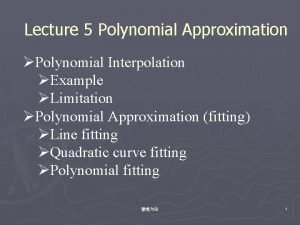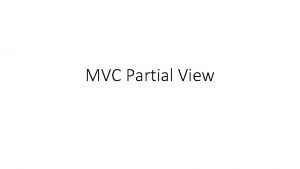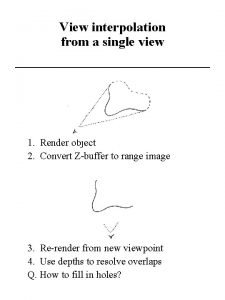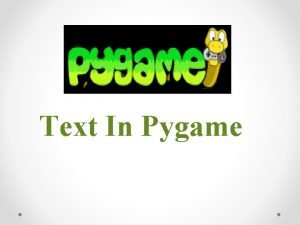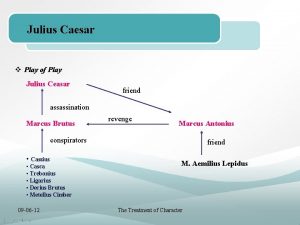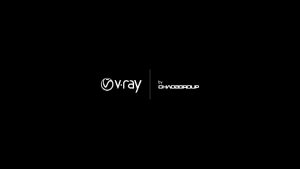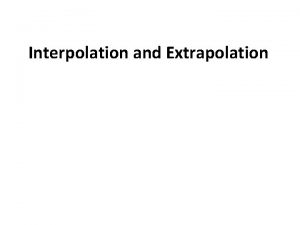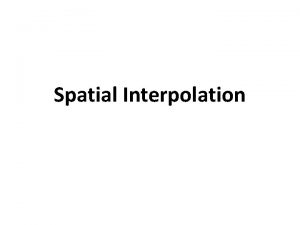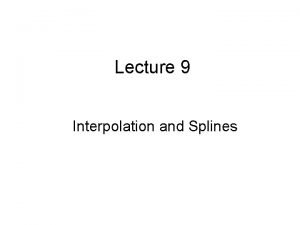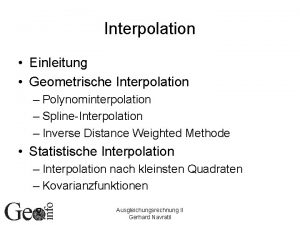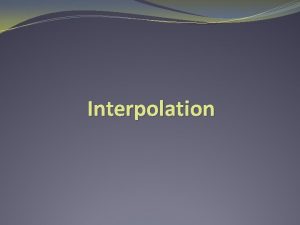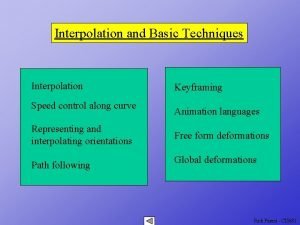View interpolation from a single view 1 Render












- Slides: 12

View interpolation from a single view 1. Render object 2. Convert Z-buffer to range image 3. Re-render from new viewpoint 4. Use depths to resolve overlaps Q. How to fill in holes?

View interpolation from multiple views 1. Render object from multiple viewpoints 2. Convert Z-buffers to range images 3. Re-render from new viewpoint 4. Use depths to resolve overlaps 5. Use multiple views to fill in holes

Problems with view interpolation • resampling the range images – block moves + image interpolation (Chen and Williams, 1993) – splatting with space-variant kernels (Mc. Millan and Bishop, 1995) – fine-grain polygon mesh (Mc. Millan et al. , 1997) • missed objects – interpolate from available pixels – use more views (from Chen and Williams)

More problems with view interpolation • Obtaining range images is hard! – use synthetic images (Chen and Williams, 1993) – epipolar analysis (Mc. Millan and Bishop, 1995) epipolar geometry cylindrical epipolar geometry

2 D image-based rendering Flythroughs of 3 D scenes from pre-acquired 2 D images • advantages – low computation compared to classical CG – cost independent of scene complexity – imagery from real or virtual scenes • limitations – static scene geometry – fixed lighting – fixed-look-from or look-at point

Apple Quick. Time VR • outward-looking – panoramic views at regularly spaced points • inward-looking – views at points on the surface of a sphere

A new solution: rebinning old views • must stay outside convex hull of the object • like rebinning in computed tomography

A light field is an array of images

Spherical 4 -DOF gantry for acquiring light fields – 0. 03 degree positioning error (1 mm) – 0. 01 degree aiming error (1 pixel) – can acquire video while in motion

Light field video camera

1 st generation prototype

2 nd generation prototype
 Spline interpolation vs polynomial interpolation
Spline interpolation vs polynomial interpolation @html partial
@html partial Qualcomm snapdragon platform unreal engine unityverge
Qualcomm snapdragon platform unreal engine unityverge View interpolation
View interpolation Pædagogens kernefaglighed
Pædagogens kernefaglighed Vray frame buffer different from saved image
Vray frame buffer different from saved image Pygame text
Pygame text Colortex render
Colortex render Julius ceasar play
Julius ceasar play Back to beauty vray
Back to beauty vray According to heizer and render, a retail/service layout
According to heizer and render, a retail/service layout Vray back to beauty
Vray back to beauty Lights, camera, render!
Lights, camera, render!
